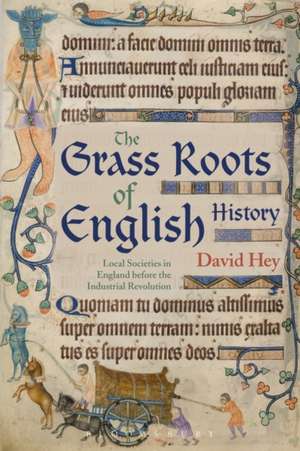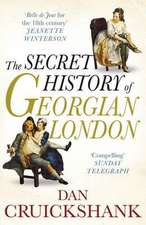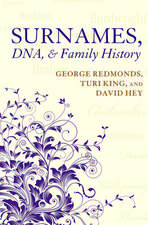The Grass Roots of English History: Local Societies in England before the Industrial Revolution
Autor David Heyen Limba Engleză Paperback – 4 mai 2016
| Toate formatele și edițiile | Preț | Express |
|---|---|---|
| Paperback (1) | 179.00 lei 3-5 săpt. | |
| Bloomsbury Publishing – 4 mai 2016 | 179.00 lei 3-5 săpt. | |
| Hardback (1) | 715.19 lei 6-8 săpt. | |
| Bloomsbury Publishing – 4 mai 2016 | 715.19 lei 6-8 săpt. |
Preț: 179.00 lei
Preț vechi: 207.74 lei
-14% Nou
Puncte Express: 269
Preț estimativ în valută:
34.26€ • 35.63$ • 28.28£
34.26€ • 35.63$ • 28.28£
Carte disponibilă
Livrare economică 25 martie-08 aprilie
Preluare comenzi: 021 569.72.76
Specificații
ISBN-13: 9781474281645
ISBN-10: 1474281648
Pagini: 240
Ilustrații: 20 bw illus
Dimensiuni: 156 x 234 x 15 mm
Greutate: 0.36 kg
Editura: Bloomsbury Publishing
Colecția Bloomsbury Academic
Locul publicării:London, United Kingdom
ISBN-10: 1474281648
Pagini: 240
Ilustrații: 20 bw illus
Dimensiuni: 156 x 234 x 15 mm
Greutate: 0.36 kg
Editura: Bloomsbury Publishing
Colecția Bloomsbury Academic
Locul publicării:London, United Kingdom
Caracteristici
Uniquely combines social and economic history with family and local history, demonstrating the connections between these approaches
Notă biografică
David Hey was Emeritus Professor of Local and Family History at the University of Sheffield, UK.
Cuprins
Preface1. Introduction: The Countries of England2. The People of England3. Organizing the Countryside: Villages, Hamlets and Farmsteads4. England's Historic Towns and Cities5. The Greatest Buildings in the Land6. Parish Churches and Chapels7. Timber-Framed Houses8. Earning a Living in the Countryside9. Packmen, Carriers and Watermen10. Family Life and SocietySelect BibliographyIndex
Recenzii
[A] work of profound imagination and reach that provides testimony to the continuing vitality of local and regional history.
A highly individual and admirable book . The Grass Roots of English History is a very personal vision of what local history might be [and] as an alternative reading of our history, it deserves our attention.
Hey (emer., Univ. of Sheffield, UK) published seminal studies on English local history for half a century, and, sadly, passed away while this book was in production. He begins this excellent survey by noting that until the 19th century, most English folk identified with their local "country"; that is, one of hundreds of small agricultural and market communities individualized variously by their distinctive dialects, farming practices, crafts, or building styles. Tax and census records reveal that descendants of core families remained in these "countries" from 1377 to 1911. Hey describes other continuities as well as the significant changes in many such locales from the time of the Roman occupation to the eve of industrial society. Highlighted along the way are recent remarkable discoveries; for example, that castles were built largely for non-military purposes, and that some existing timber-framed buildings date to the early 13th century. Although specialist studies inform the narrative throughout, Hey's attractive prose will make the book accessible to both undergraduates encountering local history for the first time and general readers-perhaps someone preparing to visit the English countryside for the 1st or 20th time. Summing Up: Highly recommended. All public and academic levels/libraries.
The book is extremely well written, strongly engaging, by an author whose work in regional history . and so many other topics is well known and highly respected. Hey's personality and intellectual persona shine through everywhere, just as they did in his gregarious and companionable life. I expected to be much interested and informed by this book on the "grass roots" and basis of English society in the early modern period, and I was.
The book is saturated with illustrative examples and fascinating detail ... Practitioners of local and family history will find this book a valuable and informative guide to academic work on local societies in pre-industrial England to help contextualise their own endeavours. Academic readers, in turn, will find some suggestive arguments that may well benefit from further research.
[The book's] most valuable ingredient is likely to be its very current updating of established interpretations in the light of recent work ... A book to make us think about how people lived in local worlds ... and to add to David Hey's important and distinctive contribution to appreciating the still developing role of local and family history in their fullest senses.
This is a book which will increase your understanding of the lives of ordinary English people.
David Hey is a celebrity among family and local historians, whose books have done more than any others to form a field, to inspire research into family history and show the relevance of this to historical studies. This book goes wider, into the 'grass roots' and basis of English society in the early modern period. It displays his intellectual persona everywhere. It is highly readable, an excellent interpretative work, up-to-date, wide-ranging in themes, regions and chronology. It is especially welcome for stressing what early modern people termed 'countries': differing regions and their distinctive qualities. It will certainly promote many further scholarly enquiries along these lines.
David Hey's latest book is a magnificent overview of England's past, which serves to unite the worlds of landscape history, family history and local history. Dealing with subjects as diverse as the distribution and meaning of English surnames, the development of the rural landscape, the origins and growth of towns, and the character and significance of parish churches and other great buildings, Hey provides a context and framework for local studies which local and family historians, as well as the general reader, will find both useful and informative. A clear, concise and immensely readable contribution to the literature.
A highly individual and admirable book . The Grass Roots of English History is a very personal vision of what local history might be [and] as an alternative reading of our history, it deserves our attention.
Hey (emer., Univ. of Sheffield, UK) published seminal studies on English local history for half a century, and, sadly, passed away while this book was in production. He begins this excellent survey by noting that until the 19th century, most English folk identified with their local "country"; that is, one of hundreds of small agricultural and market communities individualized variously by their distinctive dialects, farming practices, crafts, or building styles. Tax and census records reveal that descendants of core families remained in these "countries" from 1377 to 1911. Hey describes other continuities as well as the significant changes in many such locales from the time of the Roman occupation to the eve of industrial society. Highlighted along the way are recent remarkable discoveries; for example, that castles were built largely for non-military purposes, and that some existing timber-framed buildings date to the early 13th century. Although specialist studies inform the narrative throughout, Hey's attractive prose will make the book accessible to both undergraduates encountering local history for the first time and general readers-perhaps someone preparing to visit the English countryside for the 1st or 20th time. Summing Up: Highly recommended. All public and academic levels/libraries.
The book is extremely well written, strongly engaging, by an author whose work in regional history . and so many other topics is well known and highly respected. Hey's personality and intellectual persona shine through everywhere, just as they did in his gregarious and companionable life. I expected to be much interested and informed by this book on the "grass roots" and basis of English society in the early modern period, and I was.
The book is saturated with illustrative examples and fascinating detail ... Practitioners of local and family history will find this book a valuable and informative guide to academic work on local societies in pre-industrial England to help contextualise their own endeavours. Academic readers, in turn, will find some suggestive arguments that may well benefit from further research.
[The book's] most valuable ingredient is likely to be its very current updating of established interpretations in the light of recent work ... A book to make us think about how people lived in local worlds ... and to add to David Hey's important and distinctive contribution to appreciating the still developing role of local and family history in their fullest senses.
This is a book which will increase your understanding of the lives of ordinary English people.
David Hey is a celebrity among family and local historians, whose books have done more than any others to form a field, to inspire research into family history and show the relevance of this to historical studies. This book goes wider, into the 'grass roots' and basis of English society in the early modern period. It displays his intellectual persona everywhere. It is highly readable, an excellent interpretative work, up-to-date, wide-ranging in themes, regions and chronology. It is especially welcome for stressing what early modern people termed 'countries': differing regions and their distinctive qualities. It will certainly promote many further scholarly enquiries along these lines.
David Hey's latest book is a magnificent overview of England's past, which serves to unite the worlds of landscape history, family history and local history. Dealing with subjects as diverse as the distribution and meaning of English surnames, the development of the rural landscape, the origins and growth of towns, and the character and significance of parish churches and other great buildings, Hey provides a context and framework for local studies which local and family historians, as well as the general reader, will find both useful and informative. A clear, concise and immensely readable contribution to the literature.















